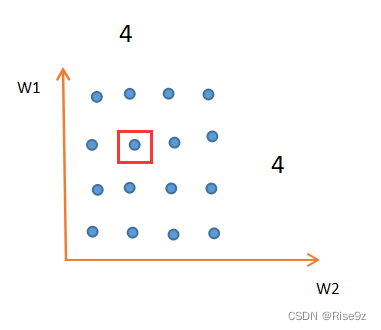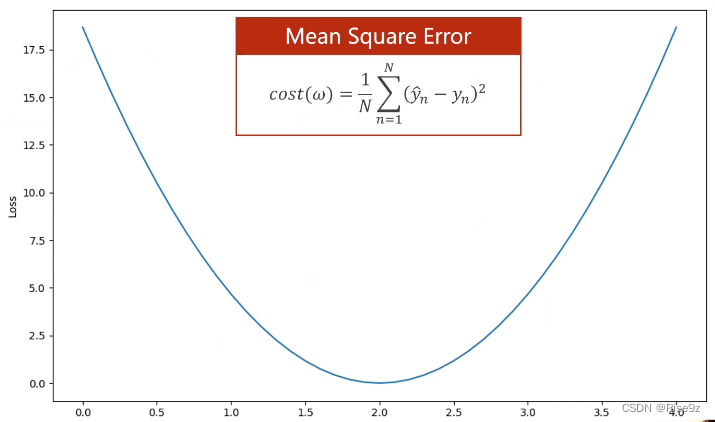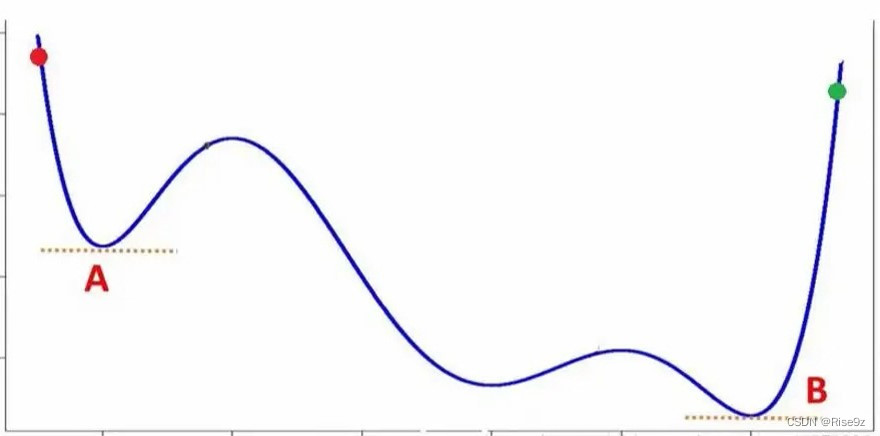目录
随机梯度下降(Stochastic Gradient Descent)

上一次我们画出上面线性图所用的数据使用穷举法所求得的,但同时方法也存在弊端:
当权重w只有一个时,还能简单的用线性表示出来,
如果出现两个权重时,如y_hat(w1,w2x), 那就需要我们在一个平面上表示出来,所搜索的数量可能达到n^2个,
如果权重出现两个以上时,10个权重就需要搜索n^10次。
所以我们换一种思路,采用分治法。
举个例子:当出现两个权重w时,首先我们将其划分为16个区域,如1所示,我们得出在红色框内取得最小值,紧接着,我们同样对红色框内的区域进行划分,如2所示16个区域,得出更准确的最小区域所代表的权重组合。


这样一来,原本需要16*16=256次的搜索,现在变成只需要16+16=32次。
但是,这种方法同样存在缺陷,因为我们的cost function(代价函数),并不完全像图3所示这样的凸函数,有可能是像图4这样的非凸函数,所以导致我们所找的最优值并不是全局最优,而是局部最优。


因此,引出我们所要讨论的优化问题,去求得函数的最小值w*。

梯度下降算法

初始点(Initial Guess) 到达全局的最小值(Global cost minimun)的最佳权重 w
移动方向:通过目标函数对权重求导,如果求得的导数>0,说明函数值再增加,函数往x正方向移动;如果导数<0,说明函数值在减小,函数往x负方向移动。
对于上面梯度来说,我们需要到达最低点,就需要往x负方向移动,所以取负的导数。

所以,在梯度下降算法里,我们用来更新权重的方法如上方所示(Update) a是学习率
该方法就是前面我们讲的贪心法。
那我们前面也说过了,贪心法 求得的最优点是存在弊端的,它有可能只是局部最优的,而不是我们所要的全局最优。
但是,为什么梯度下降算法仍然要采用这种方式呢?
是因为,后来研究发现,深度神经网络中的损失函数中并没有很多的局部最优点,很少。
存在一种特殊情况:鞍点 g=0

接下来就是一步一步地进行迭代。
我们拿上次的损失函数进行求导,具体过程如下:

代码1实现:
x_data = [1.0, 2.0, 3.0]
y_data = [2.0, 4.0, 6.0]
w = 3.0 # 设定初始权重
def forward(x): # 定义前馈模型
return x * w
def cost(xs, ys): # 算cost MSE
cost = 0
for x, y in zip(xs, ys): # for写个循环 zip拼装
y_pred = forward(x)
cost += (y_pred - y) ** 2 # 损失函数
return cost / len(xs) # 除以样本数量
def gradient(xs, ys): # 计算梯度
grad = 0 # 初始化
for x, y in zip(xs, ys):
grad += 2 * x * (x * w - y) # 求和 累加过程
return grad / len(xs) # 除以样本数量
print('Predict(before training)', 4, forward(4))
for epoch in range(100):
cost_val = cost(x_data, y_data) # 当前的损失值
grad_val = gradient(x_data, y_data) # 求梯度
w -= 0.01 * grad_val # 更新 Updata
print('Epoch', epoch, 'w', w, 'loss', cost_val) # 输出
print('Predict (after training)', 4, forward(4))最后的效果:


我们可以看到 随着更新次数Epoch的增多 cost不断减小,趋近于0;
同时权重w也稳定在2.00
最终我们得出,如果学习四个小时,得到的分数为8分
画出关系图
也可以利用matplotlib画出epoch与cost的关系。
epoch_list.append(epoch)
cost_list.append(cost_val)
plt.plot(epoch_list, cost_list) # 绘制线性图
plt.ylabel('cost')
plt.xlabel('epoch')
plt.show()出来的效果图如下( cost 趋近于0):

完整代码:
import matplotlib.pyplot as plt
x_data = [1.0, 2.0, 3.0]
y_data = [2.0, 4.0, 6.0]
w = 1.0 # 设定初始权重
epoch_list = [] # 准备两个空列表
cost_list = []
def forward(x): # 定义前馈模型
return x * w
def cost(xs, ys): # 算cost MSE
cost = 0
for x, y in zip(xs, ys): # for写个循环 zip拼装
y_pred = forward(x)
cost += (y_pred - y) ** 2 # 损失函数
return cost / len(xs) # 除以样本数量
def gradient(xs, ys): # 计算梯度
grad = 0 # 初始
for x, y in zip(xs, ys):
grad += 2 * x * (x * w - y) # 求和 累加过程
return grad / len(xs) # 除以样本数量
print('Predict(before training)', 4, forward(4))
for epoch in range(100):
cost_val = cost(x_data, y_data) # 当前的损失值
grad_val = gradient(x_data, y_data) # 求梯度
w -= 0.01 * grad_val # 更新 Updata
print('Epoch', epoch, 'w', w, 'loss', cost_val) # 输出
epoch_list.append(epoch)
cost_list.append(cost_val)
plt.plot(epoch_list, cost_list) # 绘制线性图
plt.ylabel('cost')
plt.xlabel('epoch')
plt.show()
print('Predict (after training)', 4, forward(4))平均加权均值
没有趋于0? 降低学习率
随机梯度下降(Stochastic Gradient Descent)

随机梯度下降是指在总数的N里随机选一个,拿单个样本的损失函数,对权重求导,进行更新。
代码2实现:(与上面类似)
x_data = [1.0, 2.0, 3.0]
y_data = [2.0, 4.0, 6.0]
w = 1.0 # 设定初始权重
def forward(x): # 定义前馈模型
return x * w
def loss(x, y): # 算loss MSE
y_pred = forward(x)
return (y_pred - y) ** 2
def gradient(x, y): # 计算梯度
return 2 * x * (x * w - y)
print('Predict(before training)', 4, forward(4))
for epoch in range(100):
for x, y in zip(x_data, y_data): # 当前的损失值
grad = gradient(x, y) # 求梯度
w -= 0.01 * grad # 更新 Updata
print("\tgrad:", x, y, grad) # 输出
print("progress:", epoch, "w=", w, "loss", 1)
print('Predict (after training)', 4, forward(4))
变换成单个样本进行训练
效果图如下:(最终结果与上面一致)


深度学习里
关于样本 ,(Batch)并行的话,性能低,时间低 代码1
(Mini-Batch)批量的话,性能高,时间高 代码2























 3199
3199

 被折叠的 条评论
为什么被折叠?
被折叠的 条评论
为什么被折叠?










